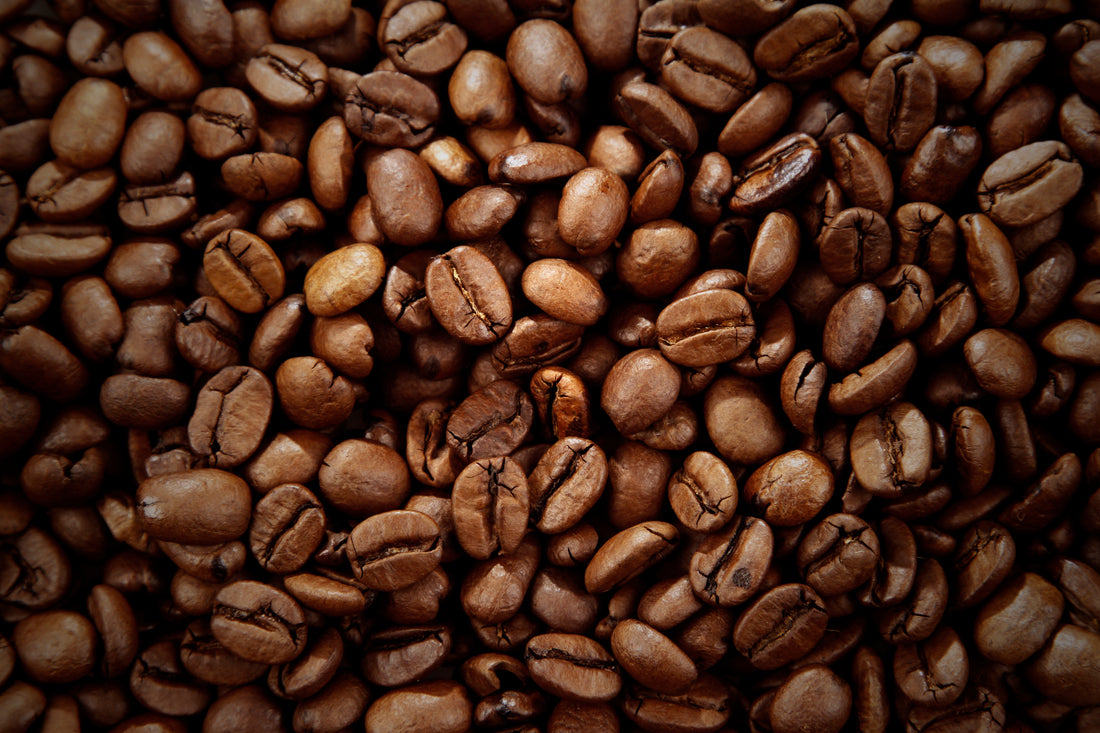
How is Coffee Made?
Share
Coffee is one of the most beloved beverages worldwide. Part of Coffee's appeal has been attributed to the fact that coffee has more caffeine content than other drinks such as tea and cocoa.
Growing Coffee Beans

Harvesting Coffee Beans
Depending on the specific variety, it takes approximately 3-4 years for newly planted coffee bushes to bear fruit. The fruit, commonly termed cherries, depending on the degree of ripeness, turn from green to bright or dark red – the unripe ones being green in color. Cherries ripen faster under lower altitudes and higher temperatures. Coffee can be hand-harvested by people to ensure that only the ripe cherries are picked. Hand-picking is a hard and labor intensive process where people need to carefully check cherries for ripeness and, naturally, it involves paid labor. Cherries mature at different periods and up to three pickings are needed to clear a farm. In countries such as Brazil where land is flat and coffee is grown on large farms, cherries are machine harvested. Whether by machines or humans, coffee is always harvested by one of the following two methods:
- Strip picking – The cherries are stripped off of the branch, either by hand or by machine
- Selective picking – The red cherries are picked and the green ones are left to ripen. Picking is carried out at 10 day intervals. Since this method is labor intensive, it is mainly used to harvest the high quality Arabica coffee.
In most regions there is one major harvest season in a year. However in several countries, such as Kenya and Colombia, there are two harvesting seasons; a main and a secondary crop. The coffee harvested at the beginning and end of the season has a poorly developed flavor, while the pick from the middle of the season has the best flavor. Good roasters buy their coffee during mid-season.
Cherry processing
After harvesting, cherries are processed as soon as possible to avoid spoilage. Depending on available resources and location, one of the following two methods is used.
The dry method
This is the ancient method of processing cherries and is still popular in regions where water is scarce. This method is also known as ‘unwashed’ or ‘natural’ processing. Most people who own small-scale farms use the dry method. The fresh cherries are spread out on a large surface and left to dry in the sun for 15 to 20 days. They are usually put on drying beds slightly raised from the ground, to ensure air circulation around the berries. They are regularly turned and raked throughout the day to avoid fermentation and to ensure they dry evenly. The berries are then covered at night to keep them from absorbing moisture. Depending mainly on the weather conditions, the drying process may take several weeks for each individual picking run, until picked cherries have a moisture content of less than 11%. At this stage, the outer layer will have dried up and turned black and brittle. The drying makes it relatively easy to remove the outer skin.
The wet method
This method is a relatively new way of removing the skin from coffee cherries. It’s called ‘wet’ because it uses water to both move the coffee fruit through the process and to extract the beans. The wet method involves cleaning the cherries and removing unripe and overripe cherries; just as in the first method. The cherries are then put through a pulping machine that squeezes out the skin without damaging the beans. This is made possible by the fact that coffee beans are relatively hard. If some berries are still left with the pulp on, they are not ripe enough.
These beans are hand sorted and are used to produce lower quality coffee. Coffee pulping leaves mucilage, which is then put into large tanks with enzymes being added to help get rid of the sticky substance. Beans are put in large tanks and stirred often to ensure all the mucilage is dissolved. The entire process takes approximately 24 hours. It’s important to remove all the mucilage to ensure beans are left with the flavor that was developed prior to this processing. After it has dissolved the beans are washed repeatedly to remove any leftover stickiness. The naked coffee beans are then dried in the sun for a day or two. It is worth noting that drying can also be mechanized. At this point the coffee beans leave the processing area and are sorted into different grades. The dry beans are called parchment coffee.
Coffee milling process
Before being taken to the market, the dried coffee beans are processed as follows: Hulling: Hulling parchment coffee involves removing the dried husk; exocarp, mesocarp and endocarp. Polishing: Coffee polishing is an optional step that is skipped by some millers. It involves getting rid of any sliver skin that may have found its way through hulling. Polished beans are considered to be of a higher quality than unpolished ones.
However, in terms of content, there is little difference. Grading: The beans are then sorted and graded based on size and weight. The polished beans are also checked for color inconsistencies and other flaws with human hands being used to remove any flawed beans. The process is painstaking and can take several hours. A better method is sorting them pneumatically using an air jet to separate the light from the heavy beans. The beans are sized by putting them through a series of screens with holes that only allow a certain size of beans to pass through. The sizing takes place on a scale of one to ten. At the end of the milling process, only the finest beans are packaged for sale to the high-end markets. In some countries the lower quality beans are not discarded; instead they are taken for processing and sold as low-quality coffee.
Coffee tasting process
The packed coffee is repeatedly tasted to additionally check and define its taste and quality. The process is called capping and it takes place in a special room designed to enhance it. Tasting helps people to tell where the coffee is from. The process shouldn’t intimidate you; anyone can take part in it. It involves gurgling coffee to the back of your mouth and identifying which flavor it is. The process is quite similar to a wine tasting event. Some of the terms tasters use are:
- Acidity: Acidity describes the level of acidity of coffee. High acidity coffee is thought to be of a higher quality. Low acidity coffee is usually called soar
- The body and aftertaste are other terms used to describe the coffee. The ‘body’ refers to how the coffee feels in the mouth – for instance, it may feel heavy or extremely light. This quality is, to some extent, constant and does not depend on individual tastes.
Coffee roasting
Unroasted coffee is also known as green coffee and such beans have all the flavors locked in them. Roasting seeks to transform the green coffee into the aromatic brown beans you buy in your favorite stores. Roasting is carried out at temperatures of approximately 550F during which time the green coffee beans are turned continuously to avoid burning. Green beans are first dried until they become yellow and develop roasting smell. Once the beans register an internal temperature of 400F, the step called ‘first crack’ happens during which the beans double in size and start to turn light brown. After that, as the temperature continues to rise, the color changes to medium brown and a fragrant oil (caffeol) starts to emerge.
This roasting stage is called pyrolysis and is the heart of roasting. It gives coffee the aroma and flavor that you witness every time you drink this magical drink. At this stage, coffee is light or medium roasted and roasting process can be stopped or continued to obtain a darker roast. After first crack and first pyrolysis, beans are absorbing heat until they reach an internal temperature of around 440F, at which point the ‘second crack’ happens and the second pyrolysis begins. Beans turn from medium dark to dark brown and you can see an oily sheen. Once roasting is complete the beans are usually doused in huge amounts of water to cool them off instantly. Becoming an expert roaster takes years of training and experience. A good roaster has to know his beans and equipment. Roasting involves being able to accurately predict the internal temperature of individual beans: something that cannot be taught; it can only be learned from years of experience.
There are different types of roasts – light, medium and dark – and within these roasts each has a few levels:
- Light roasts do not produce any oil on the surface of the coffee beans. Beans are light or a moderate light brown color
- Medium roast beans are a medium light to medium brown color and are developed during the first crack
- The dark roasts produce dark charred beans that have a lot of oil on the surface. Dark roasts happen after the second crack. Depending on the roasting temperature, the color varies from medium dark brown to nearly black.
Whenever possible, roasting takes place close to where the consumer is. This is because when beans are roasted, they begin to lose their good quality immediately. Home roasting is another popular alternative. Some cafés usually offer their customers coffee roasted on site. However, in order to become an expert home roaster, one will need some training. It is not very expensive and it can be learned quickly.
Coffee grinding
The primary goal of a grind is to produce the most flavor in a cup of coffee. The type of coffee brewer used determines how fine or coarse the coffee should be ground. The type of grinding determines how fast the coffee can release its flavors. This is the reason espresso coffee is so finely ground. On the other hand, coffee prepared with filter coffee makers is coarse-grained (coarsely ground).
Packaging
Coffee packaging is very important, as any exposure to air could turn the coffee into a lump. This is especially the case for ground coffee, which can quickly lose its flavor if exposed to air. This is the reason why coffee is usually packed in airtight containers and should be resealed carefully when not in use.
Conclusion
Coffee processing is a very human-intensive process. It requires a lot of expertise to make the right cup of coffee. Thus, one should not dismiss branded coffee.
What should you read next? What is Enzyme Coffee?




